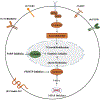Next-generation therapies for pancreatic cancer
- PMID: 38415709
- PMCID: PMC10960610
- DOI: 10.1080/17474124.2024.2322648
Next-generation therapies for pancreatic cancer
Abstract
Introduction: Pancreas ductal adenocarcinoma (PDAC) is a frequently lethal malignancy that poses unique therapeutic challenges. The current mainstay of therapy for metastatic PDAC (mPDAC) is cytotoxic chemotherapy. NALIRIFOX (liposomal irinotecan, fluorouracil, leucovorin, oxaliplatin) is an emerging standard of care in the metastatic setting. An evolving understanding of PDAC pathogenesis is driving a shift toward targeted therapy. Olaparib, a poly-ADP-ribose polymerase (PARP) inhibitor, has regulatory approval for maintenance therapy in BRCA-mutated mPDAC along with other targeted agents receiving disease-agnostic approvals including for PDAC with rare fusions and mismatch repair deficiency. Ongoing research continues to identify and evaluate an expanding array of targeted therapies for PDAC.
Areas covered: This review provides a brief overview of standard therapies for PDAC and an emphasis on current and emerging targeted therapies.
Expert opinion: There is notable potential for targeted therapies for KRAS-mutated PDAC with opportunity for meaningful benefit for a sizable portion of patients with this disease. Further, emerging approaches are focused on novel immune, tumor microenvironment, and synthetic lethality strategies.
Keywords: BRCA; KRAS; Poly-ADP ribose polymerase inhibitor; homologous recombination repair; immune checkpoint blockade; pancreatic adenocarcinoma; targeted therapy; tumor microenvironment.
Figures



References
-
- Society AC. Cancer Facts and Figures 2023. American Cancer Society. 2023.
-
- Rahib L, Smith BD, Aizenberg R, et al. Projecting Cancer Incidence and Deaths to 2030: The Unexpected Burden of Thyroid, Liver, and Pancreas Cancers in the United States. Cancer Research. 2014;74(11):2913–2921. - PubMed
-
- Owens DK, Davidson KW, Krist AH, et al. Screening for Pancreatic Cancer. JAMA. 2019;322(5):438. - PubMed
Publication types
MeSH terms
Substances
Grants and funding
LinkOut - more resources
Full Text Sources
Medical
Miscellaneous
